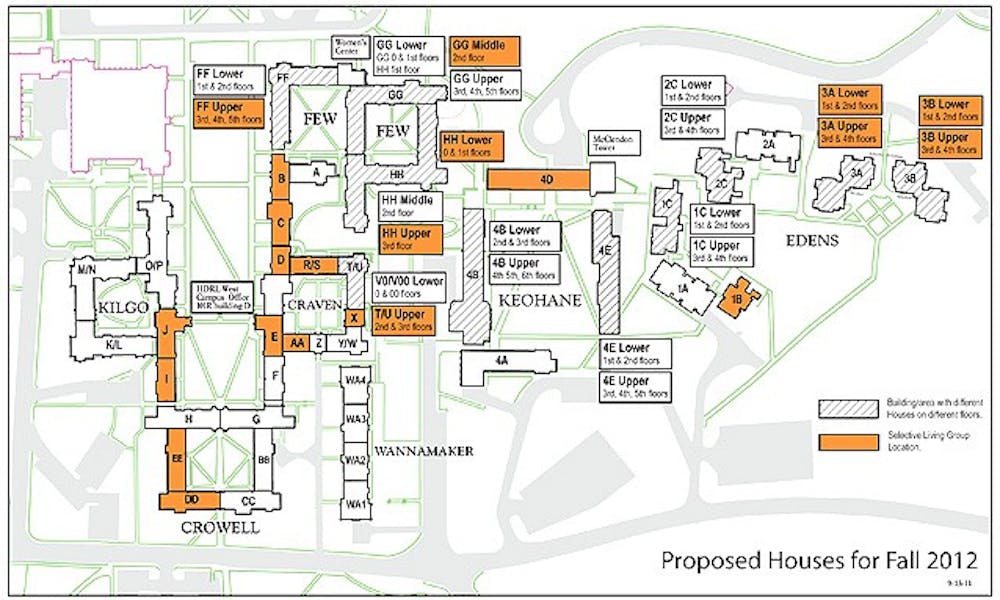There will be quite a reshuffling under the house model for selective living groups.
Under the new housing system, an increased number of selective living groups—including fraternities—will be located on Central Campus, according to the menu published on the Duke House Model website last Monday. Currently, about 30 percent of the beds on West Campus and 13 percent of the beds on Central are allocated for SLGs.
It is unknown what the exact distribution will be across the two campuses next year, though an increased presence of selective groups on Central is necessary, given that administrators want to make Central and West more equal, said Joe Gonzalez, associate dean for residence life and co-chair of the House Model Committee.
“It was only known that one of the desired goals was that the percentage of [selective] beds on the two campuses would be more similar,” Gonzalez said.
The house model menu shows how space on Central and West will be divided into selective and independent houses.
In some areas, SLGs are clustered together, and some quadrangles will feature only independent houses. All of Keohane Quadrangle—including Keohane 4E—and most of Edens, Few and Kilgo Quadrangles are planned to house independents. Wannamaker Quadrangle—currently home to three SLGs and blocks of independent students—will house independents exclusively. On Central, almost all of the houses on Alexander Avenue and clusters of houses on Erwin Road and Anderson Drive are designated to house selective groups.
Duke Student Government President Pete Schork, a senior, said he and other students on the House Model Committee objected to the way administrators planned to group SLGs and independent houses, adding that plans were worse before the house model menu was released.
Schork said logistical challenges—such as fitting larger groups into a limited number of spaces—prevented the even distribution of SLGs throughout West and Central. He added that the committee was cooperative after hearing students’ criticism about the SLG and independent clustering.
“A lot of the same type of [size] groups were being slated for Craven and Edens,” Schork said. “We all thought it was a little too concentrated.”
Steve Nowicki, dean and vice provost for undergraduate education, said house placement was largely determined by the natural constraints of Duke’s residential architecture, noting that the selection process included analyzing expected SLG recruitment and size.
Selective groups were placed into four size categories—ranging from small to medium to large to extra-large—based on a review of each group’s recruitment numbers from the last three and a half years. Administrators have not yet determined how many SLGs of each size will be on each campus, Gonzalez said, given that new groups have until the end of September to apply for a house in the model.
Ubuntu President Ming Jiu Li, a senior, said grouping SLGs together is not necessarily a bad thing, though he said he questions whether it will impact Duke’s social environment—particularly for independent students.
“I’ll be curious as to how [grouping SLGs] will affect the living experience of students,” Li said. “[Independents] may miss out on certain groups that are positive outlets for the Duke social experience.”
Nowicki said the menu did include a degree of social engineering, adding that the whole implementation of the house model emerged from student input five years ago.
“Students said ‘We are sick and tired of having a small number of students in SLGs seeming to lock up the social scene,’” Nowicki said. “It doesn’t have to be that way and it wasn’t that way in the 80s. This is an attempt to change the social scene for the better.”
The preliminary house model menu does not show specific group assignments and does not yet reflect the potential addition of new selective living groups, such as sororities.
The House Model Committee created the house model menu with the assumption that all current selective groups were to be granted a house under the model, Gonzalez said.
The committee planned for two to three more SLGs for each of the four size groups, though these additions may not be sufficient, he noted, given that the chapters in the Panhellenic Association decided to apply for housing. Each of the chapters plans to apply as a large house, which is a problem given that the committee allocated space only for the five current large SLGs—Pi Kappa Phi, Langdorm, Wayne Manor, The Nexus and Ubuntu—and two to three additional large SLGs.
Gonzalez said the committee is planning to meet this week to discuss and create an addendum to the SLG menu to allow for space for the nine sororities applying for houses.
Get The Chronicle straight to your inbox
Signup for our weekly newsletter. Cancel at any time.

